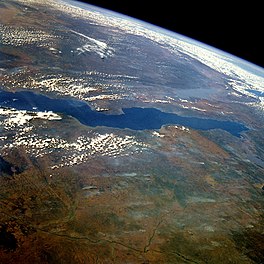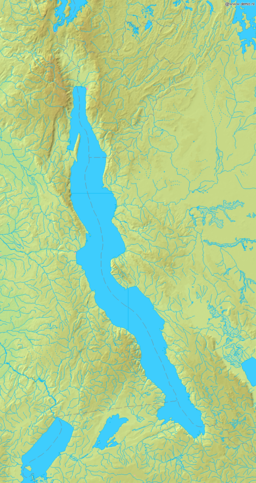
Back Tanganjikameer Afrikaans Tanganjikasee ALS ታንጋንዪካ ሀይቅ Amharic Laco Tanganica AN Tangangicamere ANG بحيرة تنجانيقا Arabic بحيرة تانجانيكا ARZ টাংগান্যিকা হ্ৰদ Assamese Llagu Tanganica AST Tanqanika Azerbaijani
| Lake Tanganyika | |
|---|---|
| Ikiyaga ca Tanganyika (Kirundi) | |
 Lake Tanganyika from space, June 1985 | |
 Lake Tanganyika map | |
| Coordinates | 6°06′S 29°30′E / 6.1°S 29.5°E |
| Lake type | Ancient lake, Rift Valley Lake |
| Primary inflows | Ruzizi River Malagarasi River Kalambo River |
| Primary outflows | Lukuga River |
| Catchment area | 231,000 km2 (89,000 sq mi) |
| Basin countries | Burundi, DR Congo, Tanzania, and Zambia |
| Max. length | 673 km (418 mi) |
| Max. width | 72 km (45 mi) |
| Surface area | 32,900 km2 (12,700 sq mi) |
| Average depth | 570 m (1,870 ft) |
| Max. depth | 1,470 m (4,820 ft) |
| Water volume | 18,750 km3 (4,500 cu mi) |
| Residence time | 5500 years[1] |
| Shore length1 | 1,828 km (1,136 mi) |
| Surface elevation | 773 m (2,536 ft)[2] |
| Settlements | Kigoma, Tanzania Rukwa, Tanzania Kalemie, the DRC Bujumbura, Burundi Mpulungu, Zambia |
| References | [2] |
| Official name | Tanganyika |
| Designated | 2 February 2007 |
| Reference no. | 1671[3] |
| 1 Shore length is not a well-defined measure. | |

Lake Tanganyika (/ˌtæŋɡənˈjiːkə, -ɡæn-/ TANG-gən-YEE-kə, -gan-;[4] Kirundi: Ikiyaga ca Tanganyika) is an African Great Lake.[5] It is the second-largest freshwater lake by volume and the second deepest, in both cases after Lake Baikal in Siberia.[6][7] It is the world's longest freshwater lake.[6] The lake is shared among four countries—Tanzania, the Democratic Republic of the Congo (the DRC), Burundi, and Zambia—with Tanzania (46%) and the DRC (40%) possessing the majority of the lake. It drains via the Lukuga River into the Congo River system, which ultimately discharges at Banana, Democratic Republic of the Congo into the Atlantic Ocean.[2]
- ^ Yohannes, Okbazghi (2008). Water resources and inter-riparian relations in the Nile basin. SUNY Press. p. 127.
- ^ a b c "LAKE TANGANYIKA". World Lake Database, International Lake Environment Committee Foundation. Retrieved 12 January 2025.
- ^ "Tanganyika". Ramsar Sites Information Service. Archived from the original on 27 April 2018. Retrieved 25 April 2018.
- ^ Wells, John C. (2008). Longman Pronunciation Dictionary (3rd ed.). Longman. ISBN 978-1-4058-8118-0.
- ^ Burton, Richard Francis (1965). Richards, Charles (ed.). Burton and Lake Tanganyika. Dar Es Salaam: East African Literature Bureau. OCLC 180480726.
- ^ a b "Lake Tanganyika". www.zambiatourism.com. Archived from the original on 22 April 2015. Retrieved 14 March 2008.
- ^ Lewis, R. (16 May 2010). "Brown Geologists Show Unprecedented Warming in Lake Tanganyika". Brown University. Archived from the original on 26 March 2017. Retrieved 25 March 2017.
